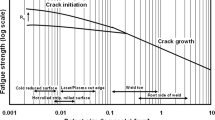Abstract
The article presents the results of investigations on the influence of the technological parameters of slide burnishing of shoulder fillets on a shaft on the fatigue strength of machine components. Fatigue tests were carried out for shafts made of X19NiCrMo4 steel after the electroslag remelting process. The burnishing process of the shoulder fillets of shafts were carried out with tools characterized by different values of tip radius and at varying angles of tool slope in relation to normal with regard to the generating line of the shaft journal. The burnishing improved fatigue strength by 28.5% compared to the non-burnished specimens. Compared with turning, the surface roughness of specimens subjected to slide burnishing decreased in the range from 64.1% to 85.8%. The measurements of the microhardness of the surface layer showed that through slide burnishing, it is possible to strengthen the surface layer by 32% down to a depth of up to 0.018 mm compared to the core hardness.
















Similar content being viewed by others
References
Zhang T, Bugtai N, Marinescu ID (2015) Burnishing of aerospace alloy: a theoretical–experimental approach. J Manuf Syst 37:472–478. https://doi.org/10.1016/j.jmsy.2014.11.004
Rodriguez A, López de Lacalle LN, Celaya A, Lamikiz A, Albizuri J (2012) Surface improvement of shafts by the deep ball-burnishing. Surf Coat Tech 206:2817–2824. https://doi.org/10.1016/j.surfcoat.2011.11.045
Soyama H, Macodiyo DO (2005) Fatigue strength improvement of gears using cavitation shotless peening. Tribol Lett 18:181–184. https://doi.org/10.1007/s11249-004-1774-7
Trauth D, Klocke F, Mattfeld P, Klink A (2013) Time-efficient prediction of the surface layer state after deep rolling using similarity mechanics approach. Procedia CIRP 9:29–34. https://doi.org/10.1016/j.procir.2013.06.163
Bednarski P, Biało D, Brostow W, Czechowski K, Polowski W, Rusek P, Toboła D (2013) Improvement of tribological properties of metal matrix composites by means of slide burnishing. Mater Sci 19:367–372. https://doi.org/10.5755/j01.ms.19.4.2404
Korzyński M, Lubas J, Świrad S, Dudek K (2011) Surface layer characteristics due to slide diamond burnishing with a cylindrical-ended tool. J Mater Process Tech 211:84–94. https://doi.org/10.1016/j.jmatprotec.2010.08.029
Konefał K, Korzynski M, Byczkowska Z, Korzynska K (2013) Improved corrosion resistance of stainless steel X6CrNiMoTi17-12-2 by slide diamond burnishing. J Mater Process Tech 213:1997–2004. https://doi.org/10.1016/j.jmatprotec.2013.05.021
Gao YK (2011) Improvement of fatigue property in 7050–T7451 aluminum alloy by laser peening and shot peening. Mater Sci Eng 528:3823–3828. https://doi.org/10.1016/j.msea.2011.01.077
Śledź M, Stachowicz F, Zielecki W (2015) The effect of shot peening on the fatigue strength of steel sheets. Kov Mat 53:91–95. https://doi.org/10.4149/km2015291
Kowalik M (2010) Application of longitudinal cold rolling method in mass production of stepped shafts used in combustion engines. Arch Civ Mech Eng 10:45–56. https://doi.org/10.1016/S1644-9665(12)60030-2
Hiegemann L, Weddeling C, Tekkaya AE Analytical contact pressure model for predicting roughness of ball burnished surfaces. J Mater Process Tech 232:63–77. https://doi.org/10.1016/j.jmatprotec.2016.01.024
Buldum BB, Cagan SC (2018) Study of ball burnishing process on the surface roughness and microhardness of AZ91D alloy. Exp Techniques 42:233–241. https://doi.org/10.1007/s40799-017-0228-8
He D, Wang B, Zhang J, Liao S, Deng WJ (2018) Investigation of interference effects on the burnishing process. Int J Adv Manuf Tech 94:1–10. https://doi.org/10.1007/s00170-017-0640-3
Laine SJ, Knowles KM, Doorbar PJ, Cutts RD, Rugg D (2017) Microstructural characterization of metallic shot peened and laser shock peened Ti-6Al-4V. Acta Mater 123:350–361. https://doi.org/10.1016/j.actamat.2016.10.044
Korzyński M (2007) Slide burnishing. WNT, Warsaw
Tanaka H, Tabuto H, Yanagi K, Futamura M (2009) Effect of surface hardened steel texture of preliminary process on burnishing process: a metrological study of hardened steel surface finishing using diamond burnishing tool. J Jpn Soc Technol Plast 50:555–559 (in Japanese). https://doi.org/10.9773/sosei.50.555
Korzyński M, Pacana A, Cwanek J (2009) Fatigue strength of chromium coated elements and possibility of its improvement with slide diamond burnishing. Surf Coat Tech 203:1670–1676. https://doi.org/10.1016/j.surfcoat.2008.12.022
Korzynski M, Zarski T (2016) Slide diamond burnishing influence on of surface stereometric structure of an AZ91 alloy. Surf Coat Tech 307:590–595. https://doi.org/10.1016/j.surfcoat.2016.09.045
Huuki J, Laakso SVA (2017) Surface improvement of shafts by the diamond burnishing and ultrasonic burnishing techniques. Int J Mach Mach Mater 19:246–259. https://doi.org/10.1504/IJMMM.2017.084007
Maximov JT, Anchev AP, Duncheva GV, Ganev N, Selimov KF, Dunchev VP (2019) Impact of slide diamond burnishing additional parameters on fatigue behaviour of 2024-T3 Al alloy. Fatigue Fract Eng M 42:263–373. https://doi.org/10.1111/ffe.12915
Maximov JT, Anchev AP, Duncheva GV, Ganev N, Selimov KF (2017) Influence of the process parameters on the surface roughness, micro-hardness and residual stresses in slide burnishing of high-strength aluminium alloys. J Braz Soc Mech Sci Eng 39:3067–3078. https://doi.org/10.1007/s40430-016-0647-y
Sachin B, Narendranath S, Chakradhar D (2019) Sustainable diamond burnishing of 17-4 PH stainless steel for enhanced surface integrity and product performance by using a novel modified tool. Mater Res Express 6:046501. https://doi.org/10.1088/2053-1591/aaf900
Hadi YA (2019) Effect of burnishing forces on turning surfaces. Amer J Mater Eng Technol 7:1–6. https://doi.org/10.12691/materials-7-1-1
Sayahi M, Sghaier S, Belhadjsalah H (2013) Finite element analysis of ball burnishing process: comparisons between numerical results and experiments. Int J Adv Manuf Tech 67:1665–1673. https://doi.org/10.1007/s00170-012-4599-9
Luo H, Liu J, Wang L, Zhong Q (2005) Investigation of the burnishing process with PCD tool on non-ferrous metals. Int J Adv Manuf Tech 25:454–459. https://doi.org/10.1007/s00170-003-1959-5
Nestler A, Schubert A (2015) Effect of machining parameters on surface properties in slide diamond burnishing of aluminium matrix composites. Mater Today Proc 2:S156–S161. https://doi.org/10.1016/j.matpr.2015.05.033
Korzynski M (2007) Modeling and experimental validation of the force–surface roughness relation for smoothing burnishing with a spherical tool. Int J Mach Tools Manu 47:1956–1964. https://doi.org/10.1016/j.ijmachtools.2007.03.002
PN-72/H-84035:1972. Alloyed structural steels for super loading equipment – grades: Warsaw, Polish Committee for Standardization, 1972
EN ISO 4287:1999. Geometrical Product Specifications (GPS) - Surface texture: profile method – Terms, definitions and surface texture parameters. Geneva: International Organisation for Standardization; 1999
EN ISO 6507–1:2005. Metallic materials - Vickers hardness test - Part 1: Test method. Geneva: International Organisation for Standardization; 1999
Author information
Authors and Affiliations
Corresponding author
Additional information
Publisher’s note
Springer Nature remains neutral with regard to jurisdictional claims in published maps and institutional affiliations.
Rights and permissions
About this article
Cite this article
Zielecki, W., Bucior, M., Trzepiecinski, T. et al. Effect of slide burnishing of shoulder fillets on the fatigue strength of X19NiCrMo4 steel shafts. Int J Adv Manuf Technol 106, 2583–2593 (2020). https://doi.org/10.1007/s00170-019-04815-7
Received:
Accepted:
Published:
Issue Date:
DOI: https://doi.org/10.1007/s00170-019-04815-7




